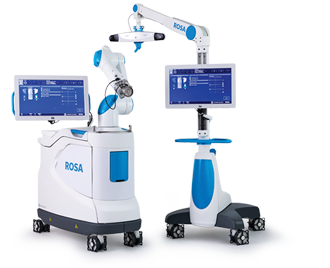You’re unique, and so is your individual anatomy. That’s why Zimmer Biomet offers ROSA® Knee robotic technology. ROSA, which stands for Robotic Surgical Assistant, is designed to help your specially trained surgeon tailor the placement of your knee implant just for you. Here, we will explain what makes the ROSA Knee System unique, what to expect preoperatively, what will happen with ROSA Knee during surgery and what to expect after your surgery.

Getting a precise knee implant fit is important to your comfort and overall experience following knee replacement surgery. ROSA Knee uses data collected before and during surgery to inform your surgeon of many details related to your unique anatomy that may affect your implant fit. By using this data to make more informed decisions, your surgeon is able to plan for and carry out a personalized surgery based upon your individual needs.
The knee is a hinge joint formed by the tibia (shinbone), femur (thighbone), and patella (kneecap). The ends of the bones in the knee joint are covered with cartilage, a tough, lubricating tissue that helps cushion the bones during movement.
Osteoarthritis, the most common form of arthritis, is a wear-and-tear condition that destroys joint cartilage and bone. It typically develops after years of constant motion and pressure in the joints. As the cartilage continues to wear away, the joint becomes increasingly painful and difficult to move. If conservative treatment options fail to provide relief, your surgeon may recommend total knee replacement using ROSA Knee robotic technology.
The surgical procedure using ROSA Knee is similar to traditional total knee replacement, but with a robotic assistant. Your surgeon has been specially trained to use ROSA Knee in order to personalize the surgical approach for your unique anatomy. It’s important to understand that the robot does not operate on its own. That means it does not move unless your surgeon prompts it to. Your surgeon is still in the operating room the entire time and is making all of the decisions throughout your surgery.
Following surgery, you will be hospitalized based upon the recovery plan your surgeon decides is best for you. This hospitalization may range from one to three days. Recovery time varies, but most people should be able to drive after two weeks, garden after three to four weeks, and golf after six to eight weeks. Your surgeon will tell you when and what activities you can return to, and what activities to avoid.
While uncommon, complications can occur during and after surgery. Some complications include, but are not limited to, infection, blood clots, implant breakage, malalignment and premature wear, any of which can require additional surgery. Although implant surgery is extremely successful in most cases, some patients still experience stiffness and pain. No implant will last forever, and factors such as your post-surgery activities and weight can affect longevity. Be sure to discuss these and other risks with your surgeon.
There are many things that your surgeon may do to minimize the potential for complications. Your surgeon may have you see a medical physician before surgery to obtain tests. You may also need to have your dental work up-to-date and may be shown how to prepare your home to avoid falls.
The decision to have surgery is sometimes difficult. We hope this has helped you understand the ROSA Knee System so that you can make the best decision for yourself. This information is not intended to replace the experience and counsel of your orthopedic surgeon. If you have any further questions, please speak with your orthopedic surgeon.